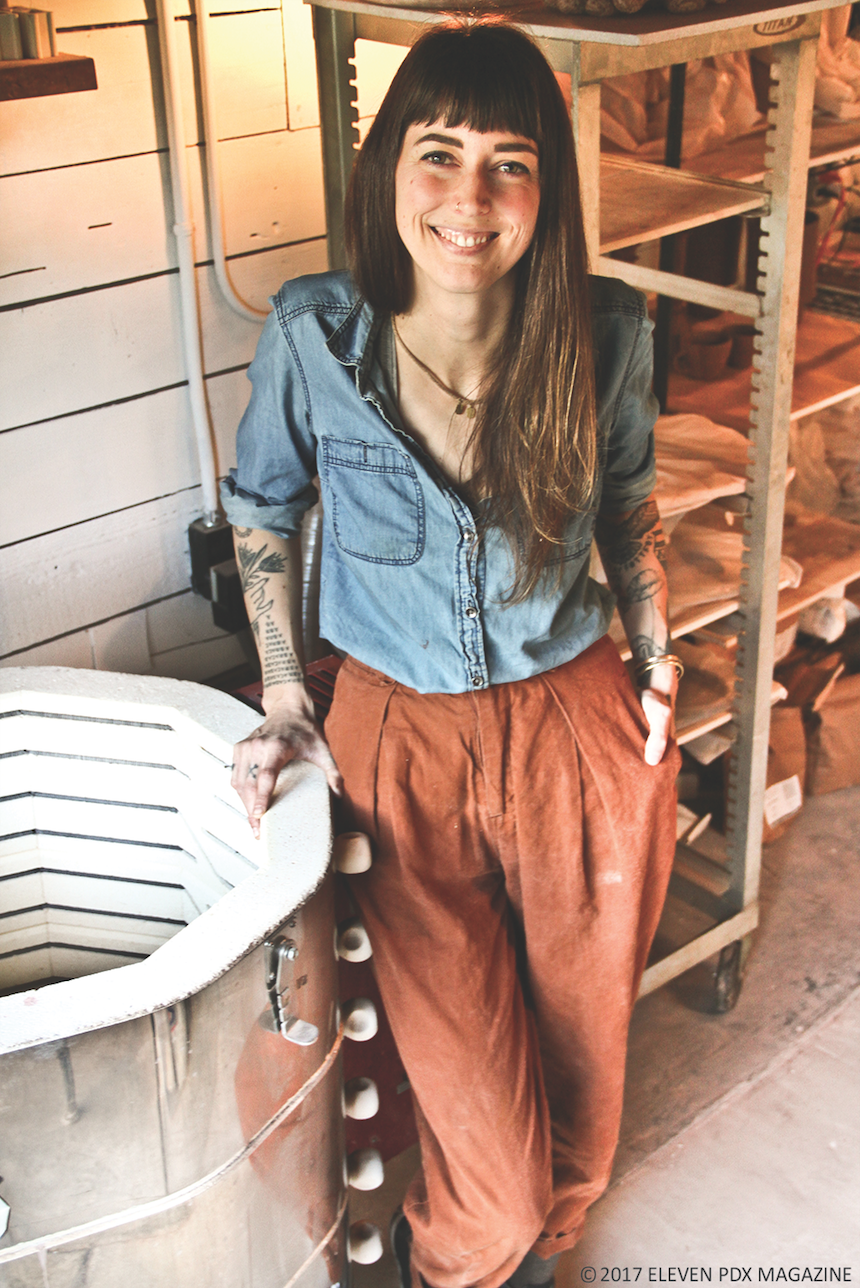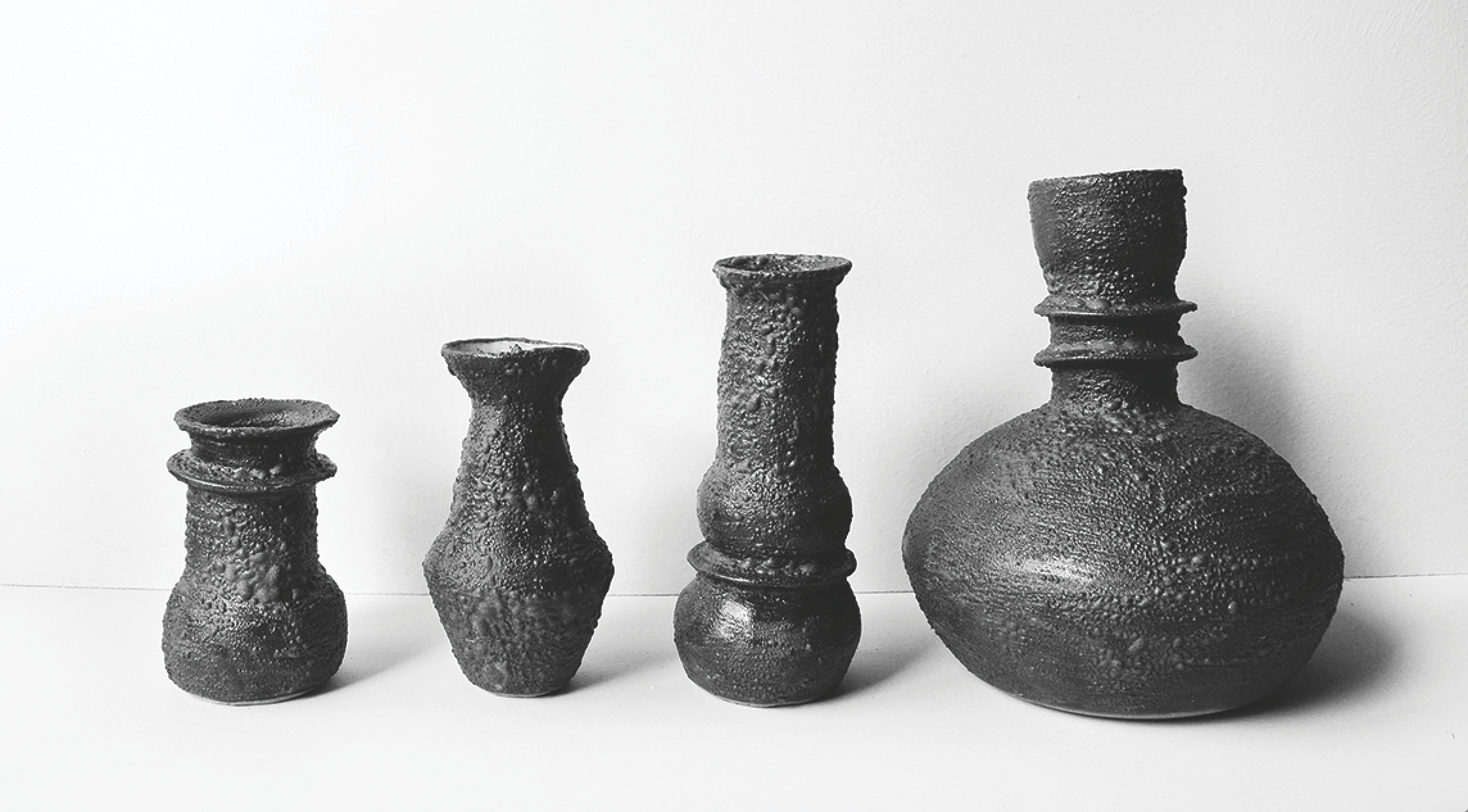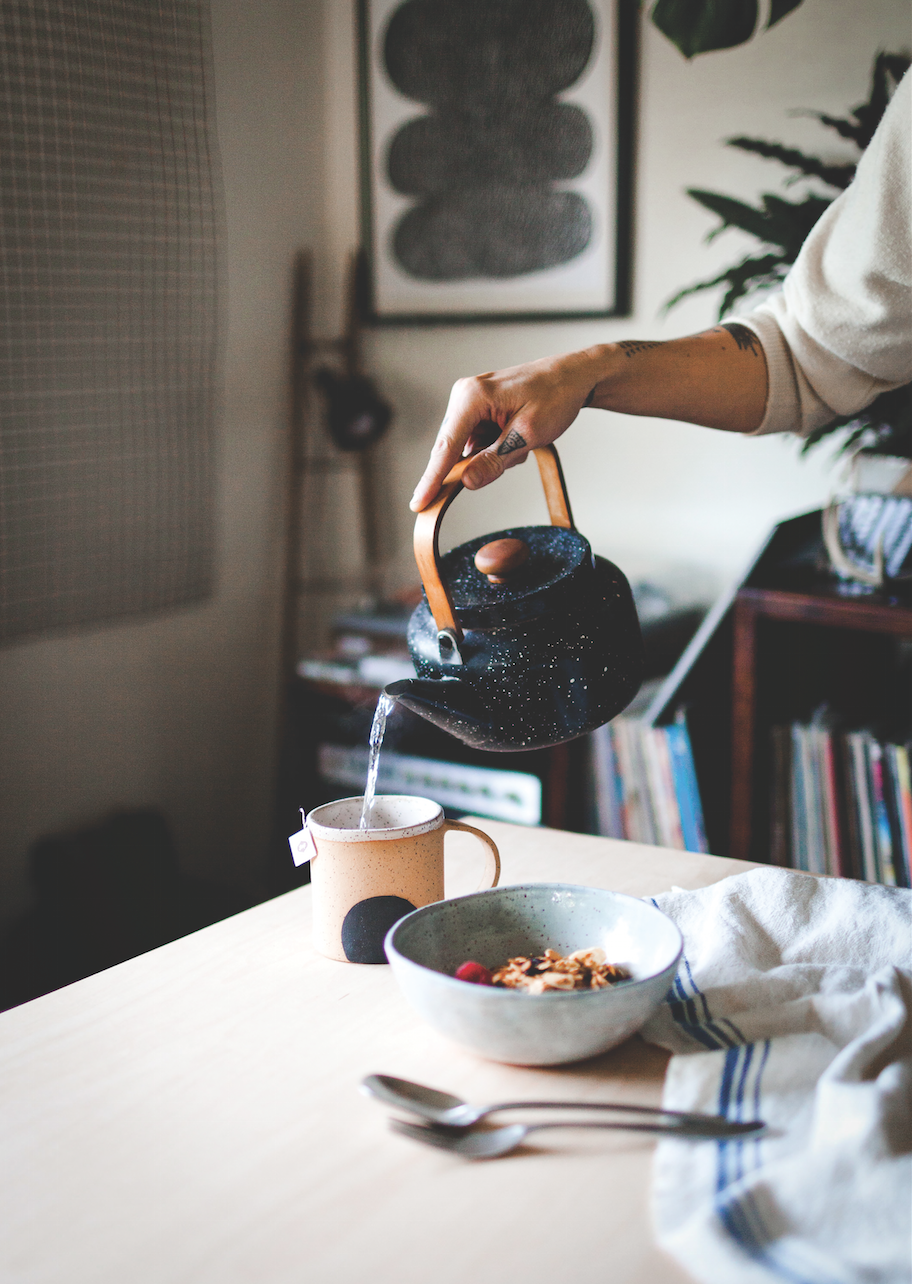Portland ceramics artist Martina Thornhill


This month, Eleven had the pleasure of stepping into a converted toolshed that has pumped out ceramic treasures for customers across the world. Entering Martina Thornhill’s studio through carriage doors, it’s illuminated with just the right amount of natural light. A large, concrete electric kiln takes up a large portion of the immediate studio space. Off in the corner, a collection of the many tiny clay testers showcase the possible glazes and textures of her intricate variety of hand-formed clay wares. Thornhill sits us down in front of her long, wooden work table to discuss how she has made her creative pursuit her career and how her work has been recently transformed through her journey into motherhood.
Eleven: How does your studio space inform the work that you do?
Martina Thornhill: The way I produce work is kind of forced by my studio because when I fire the kiln it gets really warm in here. So if anything is not dry enough it will usually dry it out too fast and create cracks in the pottery. I can’t really continuously fire; I have to build a bunch of stuff over a couple of months until I have a few kiln loads worth and then I fire them all at once.
Firing in the kiln usually takes about 15-20 hours depending on the firing setting. So I usually start to fire at night and then open it back up the following evening after it has had a chance to cool down. Sometimes it’s frustrating in this small environment, especially with the push from my social media presence and being able to keep up with production.
11: Did you build your own studio space?
MT: It was here when we bought the house. That was one of the big conditions of buying a house for us, to have an outside workspace because I didn’t want to have to fire in a basement. It was all boarded up when we first bought it, and we couldn’t really even look inside. After we bought it, we had to bolt-cut the locks off the doors. The previous owners didn’t have the combinations to the locks. The windows were all boarded up. The walls were made of wood and were all in good shape, which was a plus. We just filled in the floors with cement and added in the carriage doors for the entrance. There was a huge pile of garbage that we filled the floor in with, like a weird doll that was wrapped in a bag; all of it went into the flooring.
11: What goes into envisioning each piece? Do you have to consider who will be holding it? Or do you usually consider the functionality of what it would be used for?
MT: A lot of my pieces are more sculptural, although they are all functional pieces. I don’t make any pieces that are not functional, and I only make decorative pieces every once in awhile. I am a very practical person so if the product doesn’t have a function then it can sometimes be a little hard for me to figure out what to do with it. The handles on my mugs, for example, tend to be more of a sculptural element and are not necessarily made to be held in a traditional way, and I tend to hold the body of a mug more than I do the handles, so I think that is why I designed them that way.
11: What made you become interested in sculpture? Did that arise from wanting to create your own functional pieces, or were you just interested in sculpture as an artistic medium?
MT: I wanted to just be very functional at first. We moved out East when my husband’s mom got very sick, and we wanted to help out and help take care of her. We moved to Upstate New York for a good six or seven months. Upstate New York was really hard for both of us because it really seemed like there was nothing to do in that town, and we really felt like we didn’t fit in.
There was a ceramics studio in walking distance, and so I started taking classes there in the interest of making dishes for myself. The teacher was funny, and as I struggled to learn about using the wheel, she would gently try to suggest that maybe I should try hand building instead.
The wheel and I really aren’t friends. I think I am proficient at using the wheel now and it is OK, but it is definitely not my medium or way of making pottery. I was always really offended by her and felt like she could have done more to teach me, but when we moved to North Carolina and I took more pottery classes there, the teacher there also suggested hand building might be a better alternative. I was like, “Goddammit, seriously?” Then I finally realized that yeah, I really did like hand building a lot better.

11: On your website, you talk about how you tend to draw from you background in fiber arts. How is that?
MT: I used to sew and sell the clothing that I made, so I feel like the idea of approaching clay like I approach fabric makes more sense in my mind. I know how to cut patterns and fuse seams, so it just makes a lot more sense to me to apply that knowledge to ceramics. That is how you get these pretty basic forms in my work, that are pretty simple but they have multiple pieces to them. With my olive oil cruets, there are three pieces to the body, and then I add the rings. Some of my other pieces can be four or five pieces that I make separately and then fuse together to make the whole piece.
11: How has motherhood influenced your work?
MT: It’s absolutely had an influence. For one, there is just a lot less time. He is almost one now, 11 months, which has gone by crazy fast. When I lived on the East Coast I sold in a lot of stores, about 22 across the country. When we moved out here I started to think about selling all my work on my own online, but getting pregnant kind of got in the way of that. We got pregnant pretty soon after we moved back here, which was not really the plan.
I think it’s hard to really comprehend how much having a baby is really going to change things until they are really out. People tell you it will change your life and you agree that of course it will, but then I still managed to maintain some unreasonable expectations. For example, I thought I could be back in the studio after about six months, but then like seven months in I really realized how no way that’s going to happen. I was selling my products primarily online for myself, but now that Dodge is here, there are too many things to balance, so I have been getting back into wholesaling a little bit and getting back into a few stores again.
11: How has your son changed your priorities with your art?
MT: With Dodge, I feel like I’ve had to focus on what I really want to make. A lot of pieces that I have are pretty standard and sell well … but I don’t really enjoy making them as much as I used to: like my eye mugs and nose mugs. I still really like them, but I don’t feel as creatively fulfilled by them anymore, and that was kind of the point in me doing this in the first place.
I am not out to make a million bucks. I prefer to work by myself and not have interns. I prefer to touch everything that comes out of my studio. I want to have had laid my hands on it and be the person who made the product that has my name on it. If I have such a limited time it’s important for me to feel excited about the things I am making … Normally when Dodge goes to bed I run over to my studio with my baby monitor and that’s when I get the most time to work.
11: Do you have a favorite object that you make?
MT: I make a lot of mugs: that’s the main thing that sells and it’s easy for people. I also love making olive oil pourers. They are really fun to make sculpture-wise, and they all turn out a little bit different. I think they have cute, funny little personalities. The planters are simple and I can do them with my eyes closed so it’s kind of nice and meditative to make them for that reason. I just enjoy playing with clay. I feel really lucky that people want to buy my stuff and that I get to do that as a job.
11: Did you always want to be a pottery maker when you grew up?
MT: I never planned on selling my pottery. That was not part of my game plan. I’ve tried to make a living making stuff in various forms, so I knew that was what I would want to do as a career. Whenever I pick up a creative pursuit, I can never just make one thing. I get pretty devoted to making a lot of that product I am pursuing, so it doesn’t really work to do that without being able to sell off some it. Otherwise you just end up with a million of something and it’s not practical. I got started by making things and posting them on Instagram. Stores began hitting me up and I didn’t expect that at all, but I think it was really good timing. That’s the other thing about trying to step back from things like Instagram — I really wouldn’t have all these opportunities without it.

11: How do you think that making more functional art sets you apart from other artists?
MT: I have a hard time calling myself an artist. I didn’t go to art school. I don’t have any fine art instruction or background at all, and a lot of times people talk about prominent artists and I don’t really know who they are talking about. I actually really like what that brings to my work though, and it makes it so that my work is a little less traditional.
I have been trying a lot more to take claim of that identity and say that I am an artist, but it still just feels really weird for me to say that. Pottery is also kind of one of those things that traditionally wasn’t really accepted into the fine art world. It’s a craft, like embroidery or any sort of needlework or weaving. There has been a lot of push to have it be accepted in that realm, but it still exists in this kind of intermedium. It’s a functional thing and it’s in people’s homes and the price point is allowed to be pretty low in comparison.
11: It does seem weird to take a piece of art and be able to eat off it.
MT: Yeah, but it’s also kind of nice. It makes it a part of your everyday life. That also makes it easier to make conscious decisions as a consumer and to step away from rampant consumerism. It’s amazing for me to make wedding sets for people, for example, because maybe they don’t want to just buy mass produced products, but rather, pieces that mean something more to them. It feels different to have things like that in your home.
In this last move, I finally got rid of everything machine-made and mass-produced, and now my cupboards are filled with pieces that I have made or traded with other people, or things that I have thrifted. It’s so nice to be able to look in my cupboard and to see the variety in there.»
– Lucia Ondruskova



